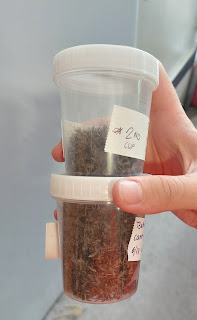Week 4: Mosquito Traps full to the brim!
 |
| A trap site in Stow, MA |
Traps Completely Full!
To the left is a CDC CO2 trap I set in Chelmsford, MA this week. What is visible in this picture are the mosquitos that are perched along the net, alive but unable to leave due to the fan. Not visible are the mosquitos that are collecting at the bottom, which outnumber the mosquitos you can see. I can tell almost immediately when I go to pick up a CDC if it caught a big collection. This week, I would say the majority of my CDCs had large collections when I picked them up.To the right is the biggest collection I have ever seen from one trap. It came from a CDC CO2 trap that I set in Tewksbury, MA right next to a wetland. The lab technicians estimate that there were about 3,000 mosquitos in that collection. It is the first time I have had to use two cups to send the mosquitos to the lab. As my coworker and fellow NEVBD intern Aoife said, "Now that is blog-worthy".
Mosquito ID
With the huge influx of mosquitos this week, the lab technicians needed all hands on deck. The other seasonals and I were assigned to sort out Coquillettidia perturbans mosquitos (which we are finding in the thousands) from the traps. There are a few key identifying traits for perturbans. The scales on their wings are not as fine as most other species, and alternate between black and white. This gives them a "salt-and-pepper" appearance that is reinforced by the white stripes on their legs and proboscis. I mentioned them last week, as they are a bridge vector of EEE. It is very concerning that we are seeing so much of them this year. According to our entomologist, we are far exceeding the number of perturbans mosquitos that we saw last year.
Apologies if this weeks recap is shorter than usual, things are getting busy around here. Thank you so much for reading!




Comments
Post a Comment